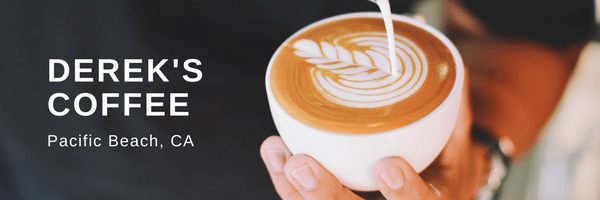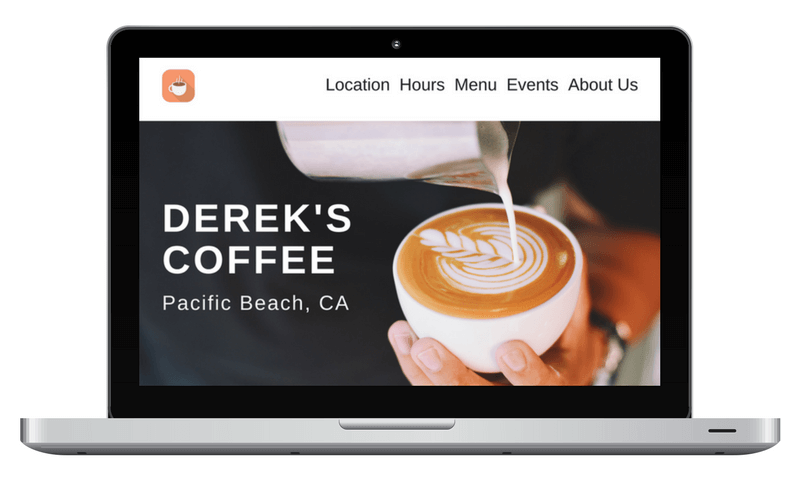
Learning 2017 SEO Basics Through A Real-Life Example
We are now halfway through 2017. Yet, we still see SEO mistakes that have been happening for years. Learn how to improve your SEO through a real-life example: Derek’s Coffee Shop.
Real-Life Example:
You are the owner of a small coffee shop in Pacific Beach, CA (that’s where we are located).

You have added your shop on Google My Business and Yelp, but you still aren’t seeing any change in traffic.
You already have a very solid social media presence on Instagram due to your incredible latte art designs you have been posting daily. However, you have not seen the growth you want with new customers.
You have been hearing that performing SEO for your small website could potentially yield more traffic and purchases. It seems that now is the time to try your hand at SEO.
Where do you start? There are two main factors that should influence your SEO strategy:
- Location (Google prioritizes searches by location)
- Main service or product (in this case it’s coffee)
Let’s just assume you have a single page website that includes location, menu, and store hours.
What can we optimize today so people can find our business easier on Google?
- Page Title
- Meta Description
- Header
- Schema Markup
- Content Structure
Let’s carry out each scenario in depth so that we can truly understand how to optimize these factors with by example.
Page Title
Overview (Of Specific SEO Factor)

Remember how I outlined location and service as the factors that will make up your SEO strategy? This is where they come into play.
Often times companies like to focus on keywords they think will bring them the most traffic.
For example, the keyword “coffee shop” is searched for 1,200,000 times per month. Ranking highly for that keyword would yield an incredibly high ROI (return on investment) for SEO.
However, the resources and money that goes into this generally generate a very poor ROI. These tops spots in Google search have unfortunately evolved to serve high ranking, high content producing, and high authority publications or companies (ex: Starbucks).
We must approach SEO more realistically. This is where location and services offered come into play. Most of the people that will visit your coffee shop either will live in your location or be visiting your location. How would someone search google for this?
Through research I have identified that “coffee shop pacific beach” yields 170 google searches per month. That might not seem significant, but this is hyper targeted.
If someone searches for this and finds your website on the first page, they are most likely going to visit. All you need is a positive experience, which could lead to ratings online and the all powerful word-of-mouth referral.
So what should we title our page to optimize for SEO? Best practices will dictate that using the exact keyword shall suffice. So should we title our page “Coffee Shop Pacific Beach”?
Research (Of Competitors)
Let’s check out what our competitors on the first page have done.

Neither of them used an exact keyword match, yet they are still on the first page of google. Your title doesn’t have to be exact, but it still has to be relevant to who you are as a business and what your identifier is.
Solution (For Our Own Company Website)
So what should we title our page? You can take many approaches. I always vote to keep it simple. Here are two questions to guide your titles:
- How would you describe your coffee shop in one phrase?
A friendly, neighborhood coffee shop. - What is the name of your coffee shop? (remember, location is important)
Derek’s Coffee
Proposed Titles:
Pacific Beach’s Friendly Neighborhood Coffee Shop | Derek’s Coffee
or
A Friendly Neighborhood Pacific Beach Coffee Shop | Derek’s Coffee

This title contains all of the identifiers you need for customers to identify you in a google search and it contains all the necessary ranking factors.
Technical SEO Suggestion For Title
Use 50-60 characters. This ensures that little to none of your page title is cut off in the search engine results page.
Meta Description
Overview

Many times I will read that meta descriptions do not help your SEO ranking. This may not be entirely true. It’s true, meta descriptions do not factor in on individual page-rank. They DO however, contribute to two things:
- Overall page authority
- Click-through rates
The more optimized your website is on all levels will decide how much Google trusts your website as a viable source for information or products.
Companies approach meta description in different ways. However, we have an approach we like to stick by. Let’s dive into some competitor research & examples to better illustrate.
Research
Let’s keep referencing the two competing coffee shops we have used in our previous examples.

99 Cups has a great meta description. In fact, their meta description compelled me to click on their website because it catered to me (I have since already visited). “Fair trade, organic, local.” This states what they do, how they do it, and indirectly identifies their target audience in one sentence.
The meta description is used to primarily provide a preview of what is on your web page. However, this can be supplemented by adding in unique characteristics your business offers. This can help raise click-through-rates.
Solution
Let’s work out our meta description for our own coffee shop. Derek’s hypothetical coffee shop specializes in Latte’s, live music and art, and doubles as a co-working space for entrepreneurs. How would we fit this into a meta description?
We need to coordinate this description with the page title we gave, “Pacific Beaches friendly neighborhood coffee shop.”
Proposed Meta Description:
**Pacific Beaches best lattes. Live music & art daily. Co-working space for entrepreneurs. **
or
Pacific Beach local craft coffee. Live music and art daily 5 – 7 PM. Co-working space available.

Technical SEO Suggestion For Meta Description
Meta descriptions should be fewer than 160 characters. Longer descriptions will be truncated by Google.
Header
Overview

Headers are a very important piece to SEO. Common convention is to add your desired keyword phrase and continue onto the next page.
However, we don’t suggest this practice. We prefer an approach that frames the content of your page while giving a quick description that serves as a unique identifier for your company.
Much like titles, headers should provide details that describe the main focus of your page (which generally tends to include your keyword).
Research
Many websites tend to skip out on using h1 tags in their content. However, these are of the utmost importance. These are used to help Google figure out what’s going on in your page.
Our competitors in this space, 99 Cups and Olive Tree Cafe both have forgone using H1 tags. If we fill out our h1 tags in the most optimized manner, we could see some benefits.
Solution
As we have alluded to before, our coffee shop will be a single page website. The most important information to our visitors will be locations, menu, hours, events, social media, & about us. These tags will be best utilized as H2 tags.
However, our H1 tags should be related to the content we have already provided in the title and meta description.
We will start out the flow of our page with the H1 tag. Here is our proposed H1 solution:
Pacific Beach Coffee Shop
Then I like to supplement this more specialized generic tag with sub description.
A friendly neighborhood coffee shop for creatives. World class Lattes. Live music and art. Co-working spaces available.
Technical SEO Suggestion For Header
H1: Should include important information about your page/keyword phrase.
H2: Should provide information about the main sections on your page.
H3-H6: Should provide information about sub-sections of main sections.
Content Structure
Overview
We touched on the topic of content while talking about headers. Let’s think of headers as the framers of your content. There are SEO friendly ways we can format content that could help you generate some enhancements from Google.
Research
It’s really no secret that Google favors the simple list (ordered and unordered). Let’s formulate how we can implement this into our list. Google is relatively simple. It essentially looks to answer the questions people ask.
When people search for “Pacific Beach coffee shop,” what questions are they trying to answer? I think I can answer this.
- Highest ranked coffee shop (by Yelp and other resources)
- A list formatted review article on the top coffee shops in Pacific Beach (that’s why these do so well on Google)
- Physical locations and information about these locations that make them unique or interesting
If your page has optimal page structure, Google will reward you (and your users) by showing additional information with additional links to more of your content.
Solution
Let’s work out the Derek’s Coffee Shop example to further illustrate our point. Remember the sections we previously mapped out as important? Location, menu, hours, events, overview. We can structure these sections to allow for better user experience while optimizing for SEO.
Here’s a strategy I will lay out. Feel free to disagree. We have a one-page website. So our navigation should reference different sections of that single page. Our navigation should be as follows: Location, hours, menu, events, about us.

So these links should be clickable links to reference other parts of the page. The content within these pages should be organized clearly and provide value for the user. If you’re interested in learning more, check out “How to Write for the Web.”
Technical SEO Suggestion For Content
Use ordered and unordered lists in as many sections as you can. This helps both users and bots scanning for important information.
If you’re ready to dig into your SEO and want help, let us know. We’d love to be your SEO resource.